MXA RACE TEST: 2017 SUZUKI RM-Z250: BEWARE OF SELF-FULFILLING PROPHECIES
Click on images to enlarge
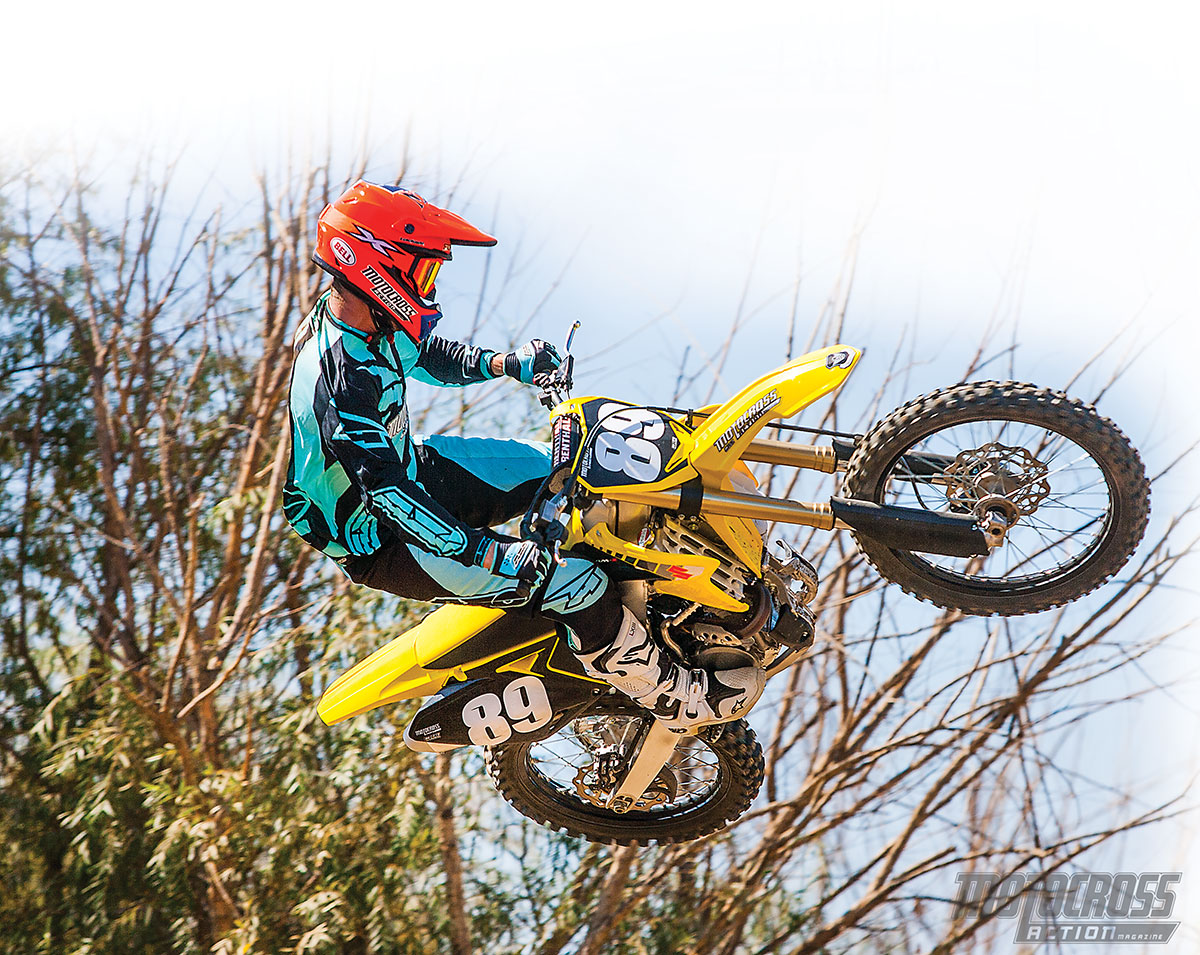
Q: FIRST AND FOREMOST, IS THE 2017 RM-Z250 BETTER THAN THE 2016 RM-Z250?
A: Suffice it to say that when you read “2017” in this test, it could just as easily mean 2016. Why? Because apart from the plastic color, graphics and anodized foof, the 2017 Suzuki RM-Z250 is the 2016 RM-Z250.
Q: ARE THERE ANY MAJOR ENGINE CHANGES ON THE 2017 SUZUKI RM-Z250?
A: No. The 2017 bike is the 2016 Suzuki RM-Z250 with a yellow rear fender and new graphics; however, Suzuki did make 80 mechanical updates to the 2016 model, including a longer head pipe, AMA-legal muffler, shot-peened piston, L-shaped oil ring, slimmer stem on the valves, new cam lobes, flat-topped valve heads, DLC-coated wrist pin, 0.5mm-smaller crank halves, a 9-percent increase in magneto inertia, a 4-percent leaner white map coupler and 4-percent richer gray coupler.
Q: WHAT WAS THE OUTCOME OF THE RM-Z250’S 80 ENGINE CHANGES IN 2016?
A: When we read the brochure stating that Suzuki had made 80 changes to the 2016 RM-Z250 engine, we couldn’t wait to ride the bike. Sadly, we were disappointed to find that the 2016 RM-Z250 engine didn’t gain any significant power over the 2015 engine, which was a carbon copy of the 2014 engine. That seemed impossible, so we dyno’ed it. It wasn’t good. So, we got a second brand-new RM-Z250 from a dealer to double-check our first dyno readings. It confirmed that the 80 changes didn’t result in any significant power gains.
What happened to the 80 all-new engine mods? We have two theories: (1) In order to improve low-end power and the transition into the midrange, Suzuki increased flywheel inertia by 9 percent and lengthened the head pipe by 40mm. While these changes made small improvements to the power from 6000 rpm to 7000 rpm, they had a negative effect on top-end power. (2) In order to meet the sound limits of both Pro and Amateur racing, Suzuki’s engineers put a V-shaped strip of perf-core into the muffler. It did a good job of knocking down the decibels, but also killed throttle response and hampered the power across the range.
 The conundrum for Suzuki is that they don’t sell very many RM-Z250s, which means the bean counters can’t justify spending millions to redesign it. That is a self-fulfilling prophecy.
The conundrum for Suzuki is that they don’t sell very many RM-Z250s, which means the bean counters can’t justify spending millions to redesign it. That is a self-fulfilling prophecy.
Q: HOW DOES THE 2017 SUZUKI RM-Z250 RUN ON THE DYNO?
A: The 2017 Suzuki RM-Z250 produces the least horsepower of any 250 four-stroke on the track today. The RM-Z250’s 38.35 horsepower is anemic compared to the 44.34 horsepower of the 2017 Husqvarna FC250. We’ll do the math for you—that’s 6 horsepower at peak. Even worse, the RM-Z250 doesn’t beat the second-worst dyno bike, the Honda CRF250, at any point on the curve. And, the Honda’s peak number is 38.89 to Suzuki’s 38.35.
Q: HOW FAST IS THE 2017 RM-Z250?
A: This engine is not fast. It lacks throttle response, aggressive hit, adequate over-rev or competitive ponies. It is, at its best, a Novice engine. It picks up nicely off the bottom and has pep into the midrange, but it is the only bike that we had to downshift to keep drive going on steep uphills.
We accept that KTM caught Honda and Suzuki napping in the R&D department. Suzuki might have been lulled into complacency by Kawasaki’s, Yamaha’s and Honda’s willingness to play the game by the established rules, which call for new designs every four years and only minor updates in the interval. KTM doesn’t play that game. For 2017 KTM went for the jugular with a 14,000-rpm bike that leapfrogged over the 2017 Suzuki RM-Z250 by 6 horsepower.
Q: WHAT IS THE BEST ATTRIBUTE OF THE 2017 RM-Z250?
A: It doesn’t take up any room in the pits, because we haven’t seen a Suzuki RM-Z250 at our local SoCal races in a couple years.
Q: WHAT’S ITS BEST ATTRIBUTE ON THE TRACK?
A: Cornering. The RM-Z250 has long held the distinction of being the best-turning bike in its class. Suzuki discovered its magical frame-geometry formula 20 years ago and has stuck with it. It can hit inside lines with very little rider input, but also blast around sweeping turns with relative accuracy. The only downside to the RM-Z250’s geometry is instability at speed. The solution? Slide the forks down in the triple clamps, tighten the steering-stem nut, and carefully adjust the race sag (it affects the frame’s head angle). Every MXA test rider was willing to trade some straight-line stability for the RM-Z250’s precise cornering ability.
Q: WHAT MODS WOULD A SUZUKI RM-Z250 RACER NEED TO MAKE?
A: We wouldn’t make any mods that required a massive outlay of cash. Why not? It would be a waste of money and time. You would need to spend $5000 on engine mods to bring the RM-Z250 engine up to parity with a showroom-stock KTM 250SXF. What mods should a 2017 Suzuki RM-Z250 owner make? Sensible ones that fix existing flaws. Here’s a quick and cheap list.
(1) Exhaust. You could order a slip-on muffler from Pro Circuit, FMF or DR.D and get back the throttle response that the perf-core restrictor took away. Or, take a long punch and knock the V-shaped offender out of the way (we weren’t brave enough to do this).
(2) Gearing. If you want to go anywhere fast, you’ve got to perk up the midrange. The quickest way to do this is by adding teeth to the rear sprocket.
(3) Couplers. The RM-Z250 couplers actually make a difference to the engine’s performance. We are particularly fond of the lean (white) coupler, but depending on your track conditions, the gray coupler (rich) or no coupler (stock) at all could be the cat’s meow. You can change the coupler in less than a minute, so take the time to test each one.
(4) Clutch. At the very least, install stiffer aftermarket clutch springs. It will save you money on clutch plates in the long run and build up your left forearm.
(5) Steering stem. Just because the RM-Z250 is the best-cornering bike in the class doesn’t mean that it’s the best-handling bike. Overall handling performance is not based on cornering alone but a combination of traits, including straight-line stability, balance at speed and rough ground manners. Unfortunately, the RM-Z250 is not very stable at high speeds or through rough terrain. We always tighten down the steering stem to eliminate wag in the front end.
(6) Front tire. Even the best-turning bike on the track can perform better with premium rubber on the front — that isn’t the 2017 RM-Z250’s Dunlop MX52. We prefer to run either a Bridgestone X30 or Dunlop MX3S front.
Q: HOW MUCH DOES THE 2017 RM-Z250 WEIGH?
A: The 2017 Suzuki RM-Z250 hits MXA’s trusty scales at 226 pounds (without gas in the tank). It’s a shame that the slowest bike in the class is also the heaviest when compared to the 218-pound KTM 250SXF, 219-pound Husqvarna FC250, 221-pound Kawasaki KX250F, 222-pound Yamaha YZ250F and 224-pound Honda CRF250.
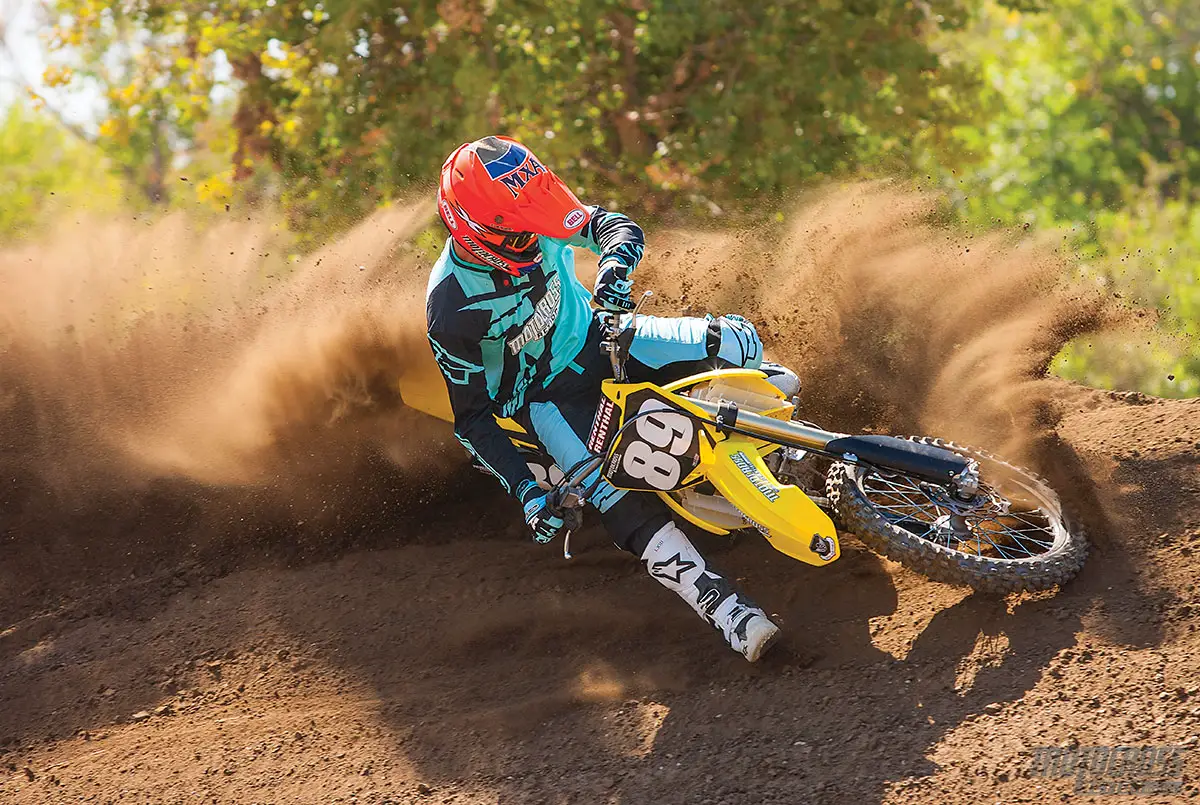
Q: HAS SUZUKI KEPT UP WITH THE TIMES?
A: The obvious answer is no. The bike’s weight, horsepower and brakes are old school; however, the biggest rap against Suzuki comes from social-media critics who claim that the 2017 Suzuki RM-Z250 is really just the 2008 RM-Z250 with BNG. Is this true? Here is a breakdown of year-to-year changes over the last decade.
2008 Suzuki RM-Z250: The aluminum frame was first introduced on the 2007 RM-Z250. Since the bike was new from the ground up in 2007, the 2008 only got Wave rotors, a right-hand hot-start lever, gold axle blocks, a gripper seat cover, gold-tone chain and slight jetting revisions to the Keihin FCR carb.
2009 Suzuki RM-Z250: There were three changes for 2009: (1) Bold new graphics on the radiator shrouds. (2) A new seat cover. (3) A yellow front number plate.
2010 Suzuki RM-Z250: The 2010 RM-Z250 got fuel injection borrowed from the 2009 RM-Z450’s system. Along with EFI came a new muffler, new cam timing, a stronger connecting rod, thicker walls on the frame-cradle tubing, an aluminum gas tank, braced swingarm, anti-mud clogging footpegs, revised spring rates, improved cooling and black backgrounds on the number plates.
2011 Suzuki RM-Z250: Suzuki made 34 changes to the 2011 RM-Z250. They included a new exhaust system, revised intake cam timing, higher-lift exhaust cam, wider third and fourth gears, increased oil capacity, redesigned kickstarter, aluminum front brake pistons, better valving on the 47mm Showa forks, updated wiring and two different map couplers.
2012 Suzuki RM-Z250: Since the 2011 RM-Z250 was totally remade, the 2012 model only got a new breather hose, lighter fuel-pump holding cover, a red stripe on the seat cover and black fork guards.
2013 Suzuki RM-Z250: The 2013 engine got a revised piston, connecting rod, piston pin, cams, oil strainer, shift cam, muffler, radiator fins and water-hose routing. The big change was the switch to 48mm Showa Separate Function (SFF) forks. This was the first year of the black rear fender, which would last through 2016.
2014 Suzuki RM-Z250: Suzuki only made two changes to the 2014 RM-Z250. The ECU had a “single-fire spark” mode that only fired the plug on the compression stroke, not the exhaust stroke. Second, the previous year’s white side panels were replaced with yellow ones.
2015 Suzuki RM-Z250: The only updates were BNG. The rear rotor guard and case guards were changed from white plastic to black, and the bar pad was black instead of red. The seat cover’s red stripe was changed to gray.
2016 Suzuki RM-Z250: The 2016 Suzuki got the 80 changes to the piston, rings, exhaust, valve stems, oil ring and crank diameter. The forks were swapped from Showa SFF to Kayaba PSF-2 air forks. Launch control was added, and the frame got a taller head tube, stronger frame cradle, redesigned webbing in the main spars and new mounting points for the subframe.
2017 Suzuki RM-Z250: The yellow rear fender returned after four years of black, and the seat cover got a yellow stripe replacing the gray stripe that had been on the RM-Z250 since 2015.
Q: WHAT DO WE HATE?
A: The hate list:
(1) Brakes. Every manufacturer, save for Suzuki, switched to oversized front brake rotors in order to keep KTM’s awesome Brembo brakes in sight. The RM-Z250 has the weakest brakes on the showroom floor. To add insult to injury, we experienced overheating issues with the rear brake.
(2) Clutch. What clutch?
(3) Engine. This was a solid midrange engine five years ago. Not anymore!
(4) Launch control. The day that skilled riders need to detune the slowest 250cc four-stroke in order to get off the gate is the day they need to take up Tiddlywinks.
(5) Tires. Although Suzuki’s R&D department has been asleep at the wheel, Dunlop’s hasn’t. Tires have come a long way since the MX52 was considered the hot ticket.
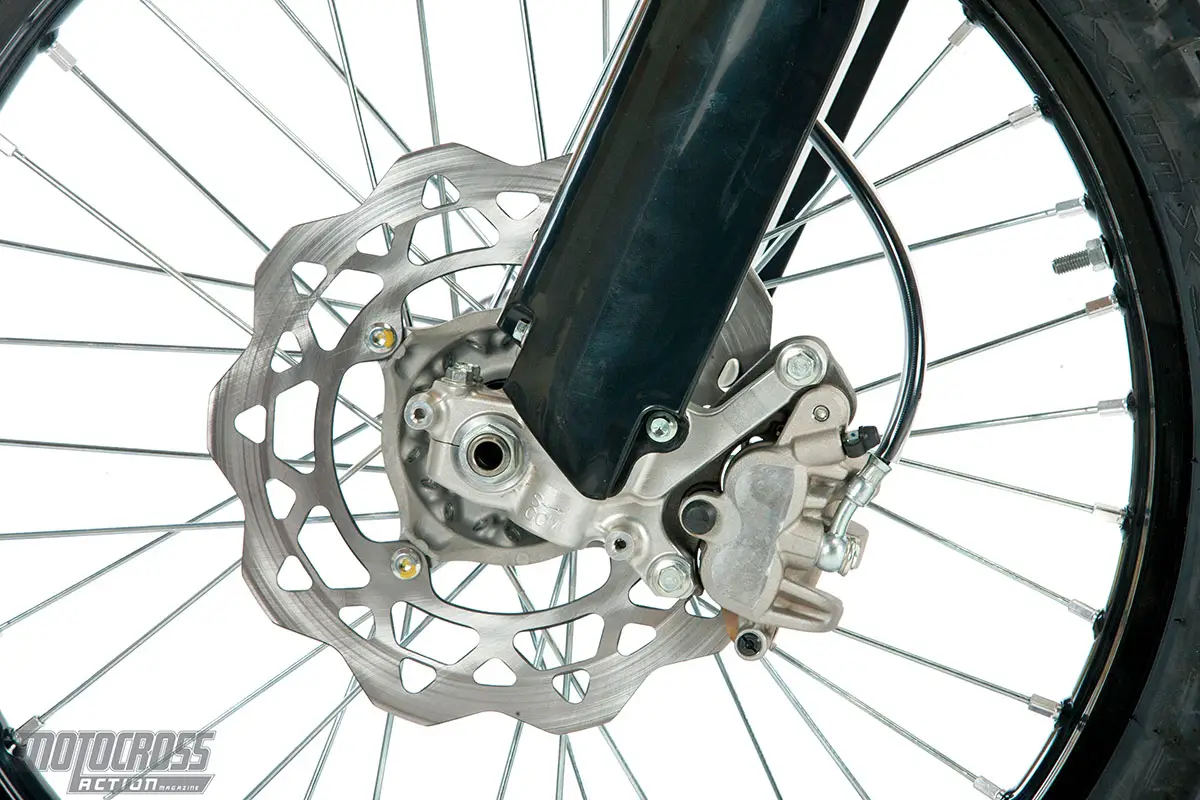
Q: WHAT DO WE LIKE?
A: The like list:
(1) Aesthetics. Thankfully, the era of the ugly black rear fender is behind us.
(2) Cornering. There’s no bike in the 250 class that can hit corners with more precision than the RM-Z250. It’s confidence-inspiring.
(3) Couplers. We love plug-ins and prefer the white plug-in.
(4) Suspension. We like the idea of low-pressure air forks like the RM-Z250’s Kayaba PSF-2 forks. Low-pressure forks have a single air chamber that only requires 35 psi instead of the TAC forks’ 170 psi. There is one major caveat: on the 2017 Suzuki RM-Z250, the clickers on both fork caps are for rebound damping only (both high- and low-speed). The compression clickers are on the bottom.
 If you need launch control on the slowest and heaviest bike in the 250 class, you need to take up tiddlywinks.
If you need launch control on the slowest and heaviest bike in the 250 class, you need to take up tiddlywinks.
Q: WHAT DO WE REALLY THINK?
A: Believe it or not, the Suzuki RM-Z250 won the 2011 MXA 250 four-stroke shootout but couldn’t win a dog show in 2017. Well, now that we think about it, you probably do believe it, because the 2017 RM-Z250 only makes a 1/2 horsepower more than it did seven years ago. Over the same time span, the KTM 250SXF gained 8 horsepower. That is the tale of the tape.
MXA’S SUZUKI RM-Z250 SETUP SPECS
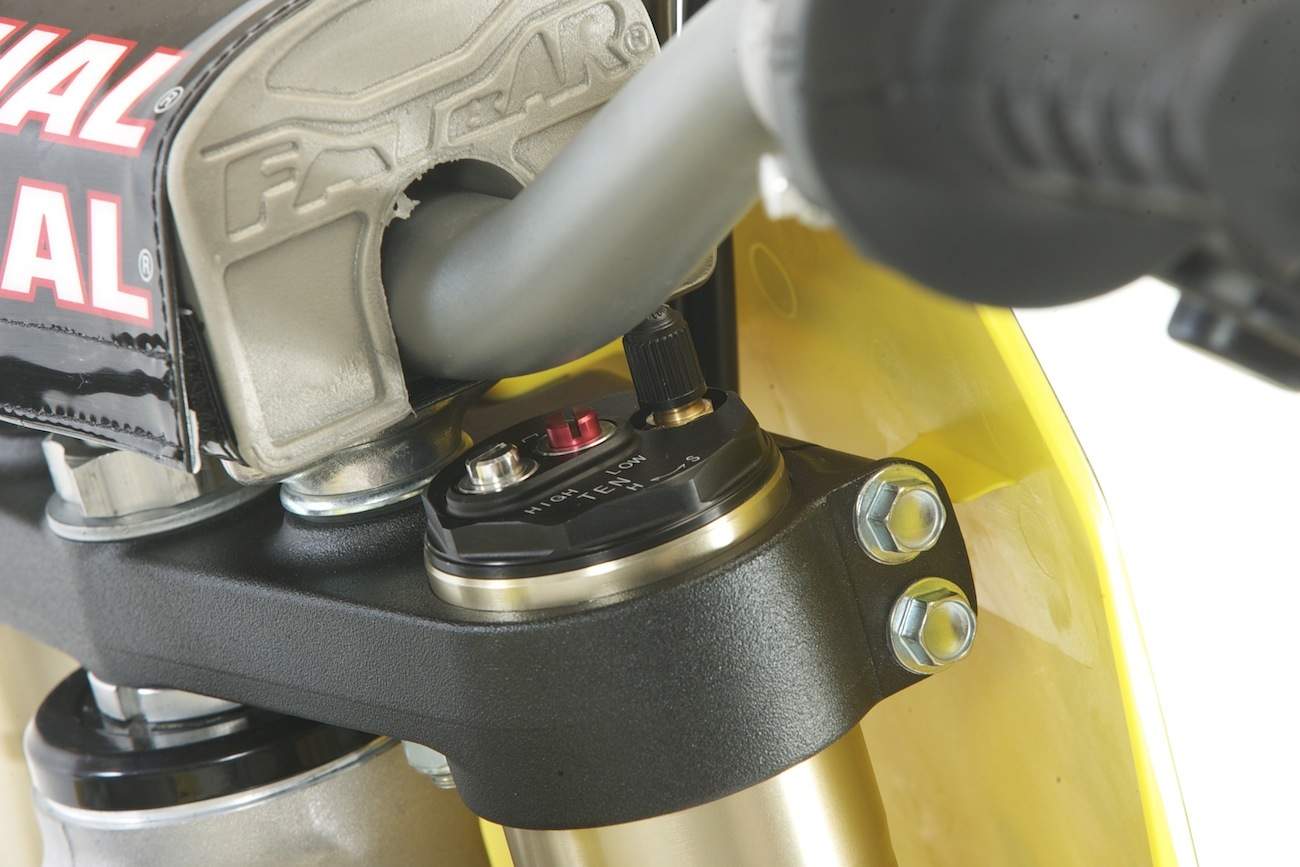 This is how we set up our 2017 Suzuki RM-Z250 for racing. We offer it as a guide to help you get your own bike dialed in.
This is how we set up our 2017 Suzuki RM-Z250 for racing. We offer it as a guide to help you get your own bike dialed in.
KAYABA PSF-2 FORK SETTINGS
Suzuki ran Showa SFF single-spring forks in 2013–’15, but for 2016–’17 they switched to Kayaba PSF-2 air forks. Suzuki’s version of PSF-2 forks differs from Honda’s in that the high- and low-speed rebound damping clickers are on the top of both fork caps, while the compression damping is on the bottom. Honda has its high- and low-speed compression clickers on one fork cap and its high- and low-speed rebound clickers on the other fork cap. For hardcore racing, these are MXA’s recommended 2017 Suzuki RM-Z250 fork settings (stock settings are in parentheses):
Spring rate: 34 psi (35 psi)
Compression (bottom of fork): 7 clicks out
Hi-rebound (silver): 15 clicks out
Lo-rebound (red): 16 clicks out
Fork-leg height: Flush
Notes: Once you find the correct air-pressure setting for your weight, speed and track, focus on making all the adjustments with the compression clickers first, the low-speed rebound clickers second and high-speed rebound last. Given our druthers, we would prefer to have high- and low-speed compression damping instead of Suzuki’s focus on incremental rebound damping.
KAYABA SHOCK SETTINGS
For hardcore racing, these are MXA’s recommended 2017 Suzuki RM-Z250 shock settings (stock settings are in parentheses):
Spring rate: 5.5 kg/mm
Race sag: 105mm
Hi-compression (blue): 9 clicks out
Lo-compression (silver): 10 clicks out
Hi-rebound (bottom of shock): 17 clicks out
Lo-rebound (red): 11 clicks out
Notes: The 5.5 kg/mm spring might be a little stiff for minicycle transplants, but use free sag as your gauge. Check the race sag at regular intervals throughout the life of the machine. Don’t discount the shock when it comes to handling. If it is too stiff or the race sag too little, the RM-Z250 can go from a sweet-handling machine to a yellow ogre. Balance the front and rear with careful setup.
MXA’S FIRST RIDE! 2017 SUZUKI RM-Z250


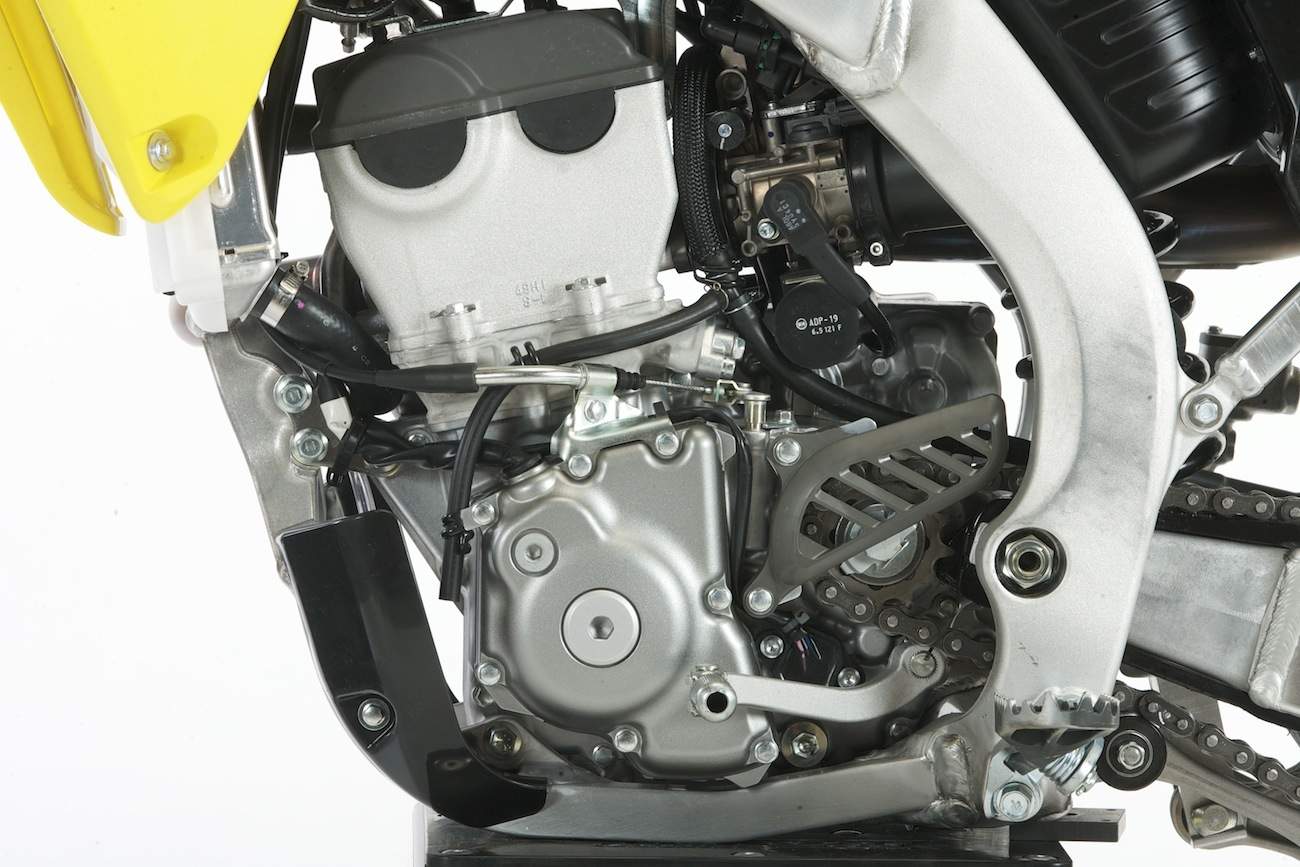

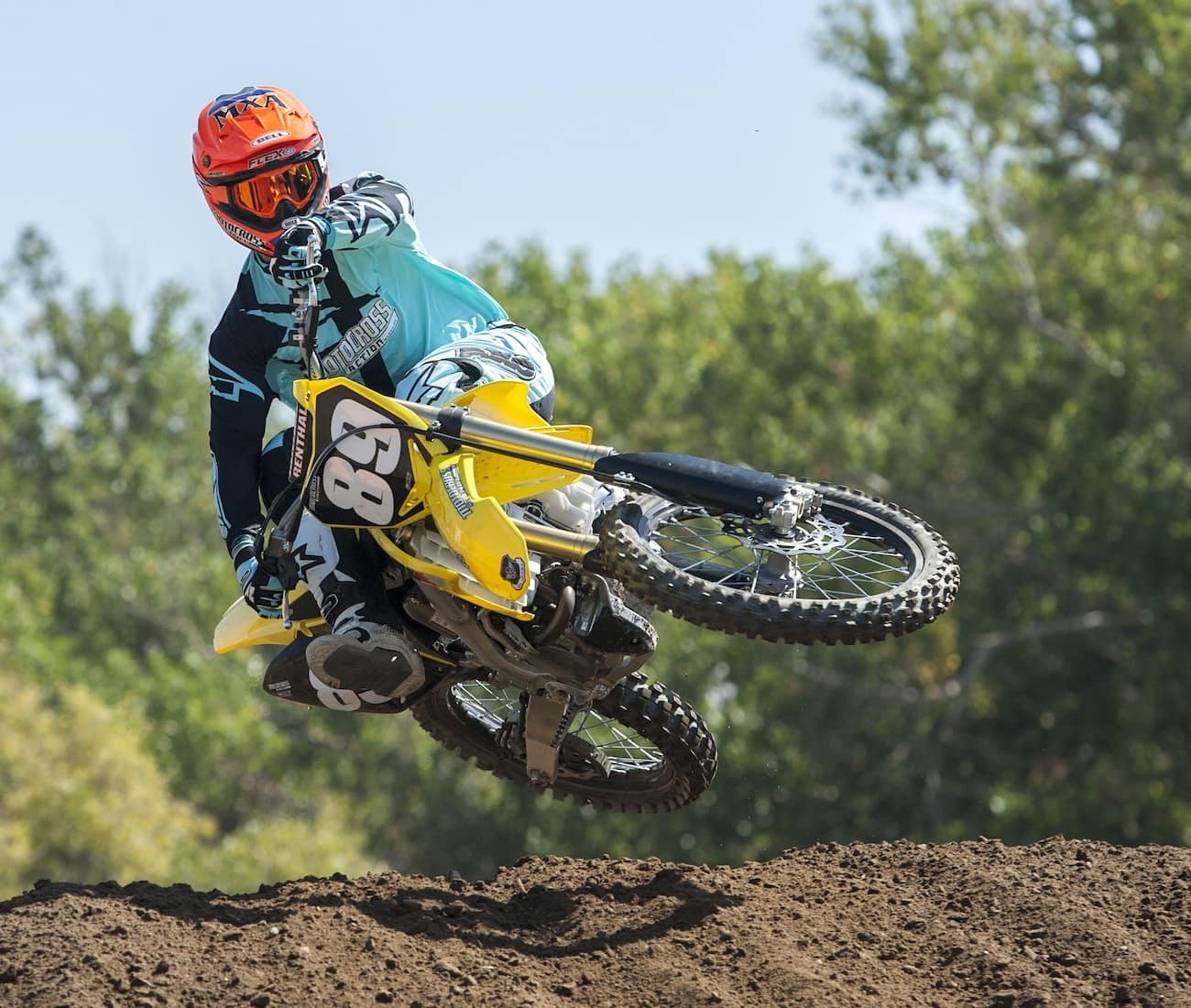

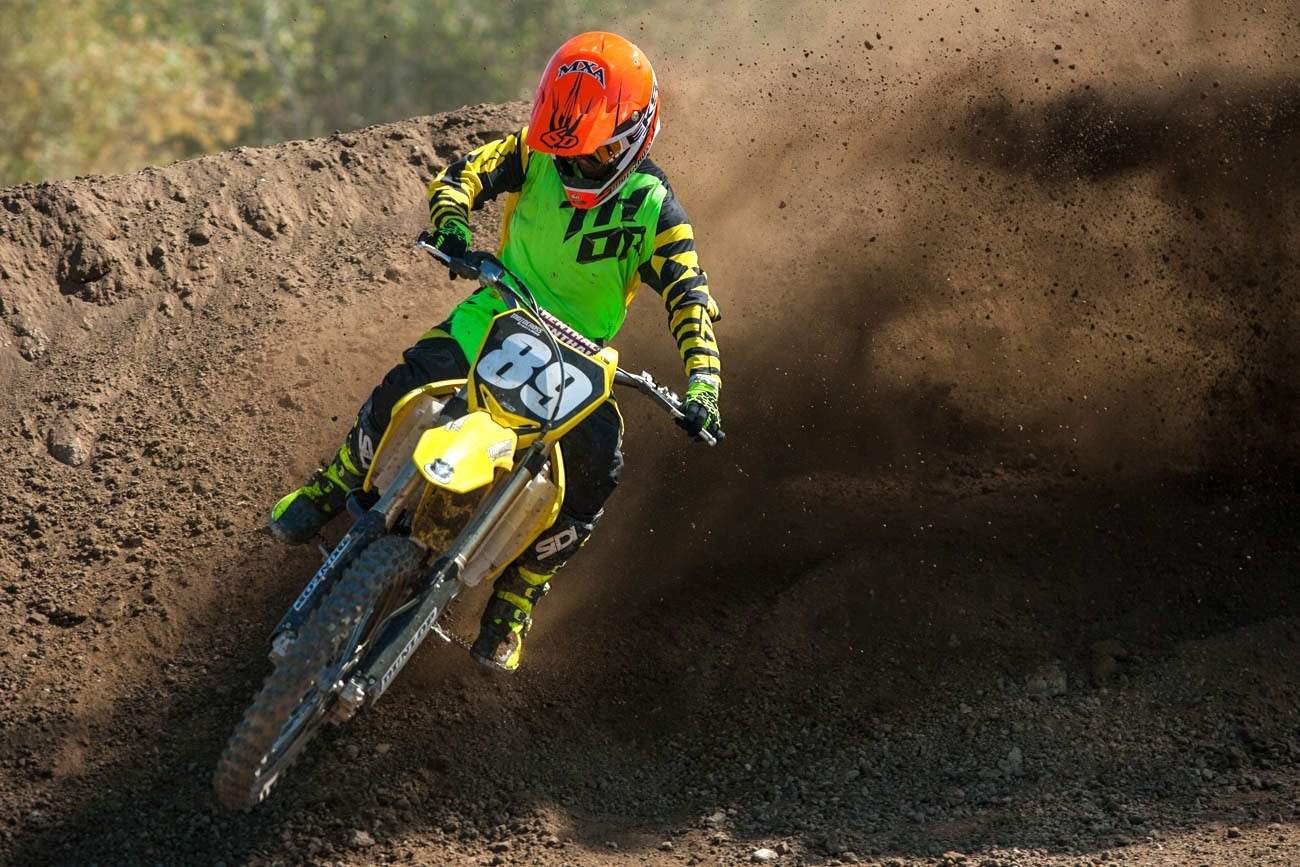
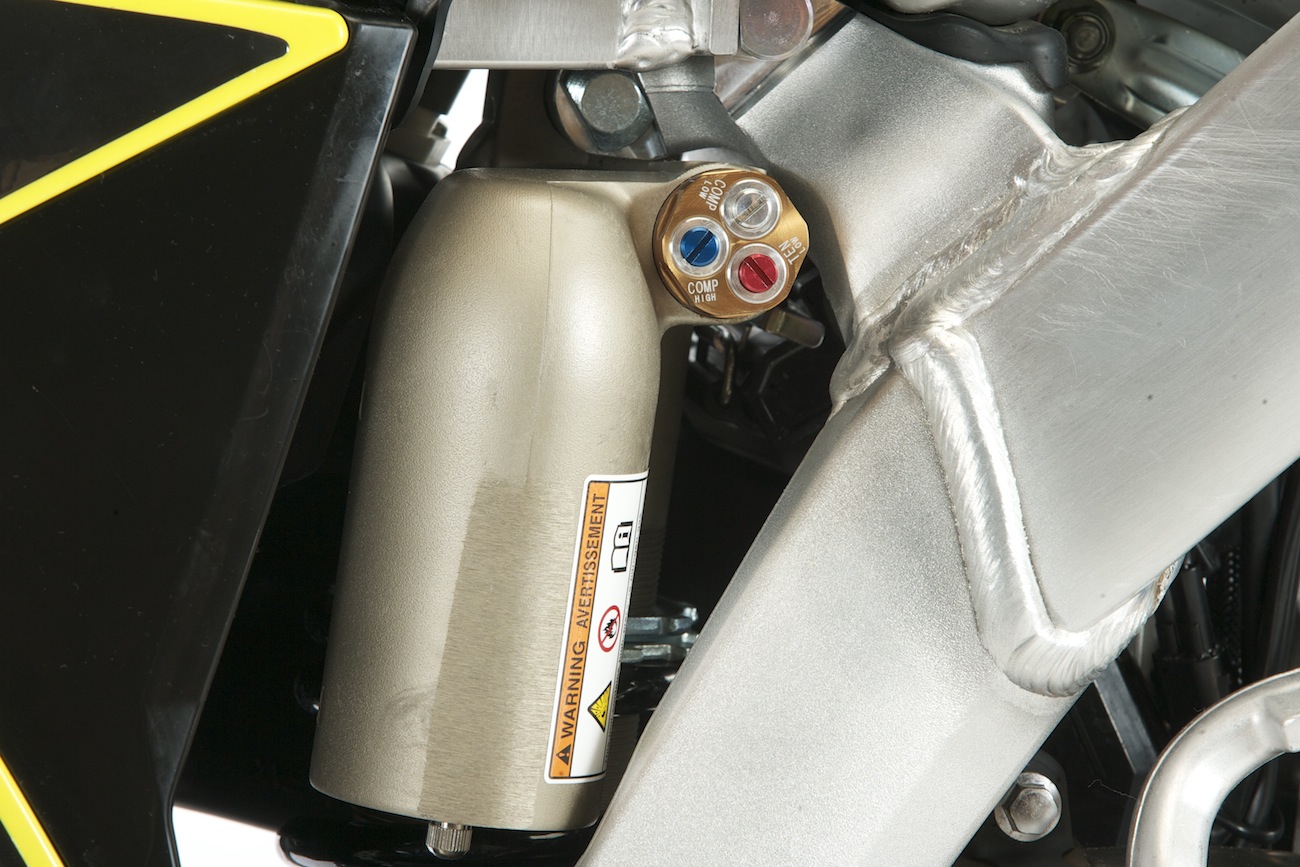



Comments are closed.